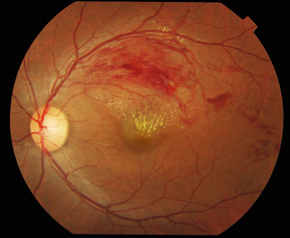Retinal vein occlusion

Retinal vein occlusions (RVOs) are the second most common type of retinal vascular disorder after diabetic retinal disease.] They can occur at almost any age but are more common in patients over 65. They occur due to a blockage in either one of the branches of the retinal vein (Branch Retinal Rein Occlusion: BRVO) or can affect all of the retinal vein (Central Retinal Vein Occlusion: CRVO). The effect on vision can be variable with some patients being asymptomatic whilst other have severe visual impairment. The loss of vision is usually due to leakage of fluid from the damaged vein which collects at the central part of the retina called the macula (macular oedema). Vision can also be affected by the vein occlusion causing an interruption to the blood supply of the macula (ischaemia). Although RVO can occur in anyone, there are known risk factors: systemic conditions such as high blood pressure, high cholesterol, diabetes, smoking raised pressure in the eye conditions where the blood is too thick or clots too easily
Treatment
If the vision has not been affected, then treatment may be required and the condition can be monitored in clinic. If the vision is affected and there is significant macular oedema, then treatment can be considered. Treatments available are intravitreal steroid implants (Ozurdex), intravitreal anti growth factor injections such as Ranibizumab (Lucentis) and Aflibercept (Eylea). The risks and benefits of all these treatments will be discussed prior to commencement of any therapy.

Occasionally the blood supply to the retina can be affected by the vein occlusion which causes ischaemia. This can lead to the formation of abnormal blood vessels within the retina and elsewhere in the eye which can caused raised pressure (glaucoma). Laser can be used to prevent the formation of these abnormal blood vessels and subsequent complications.
As well as treatment of the eye itself, blood tests and a blood pressure measurement will also be taken to identify any risk factors that may have caused the retinal vein occlusion.


